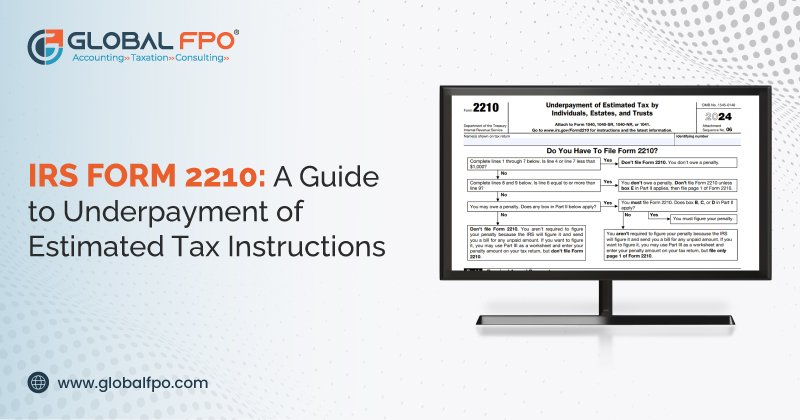
Taxes can be complicated, and sometimes people don’t pay enough throughout the year. If you don’t pay enough in taxes, you might face a penalty from the IRS. That’s where IRS Form 2210 comes in. This form helps taxpayers figure out if they owe a penalty for underpaying their estimated taxes and how much they need to pay. This guide will explain everything you need to know about IRS Form 2210 in a simple way.
IRS Form 2210 is used by the IRS to determine if you owe a penalty for not paying enough estimated taxes. This applies to individuals, estates, and trusts. If you have income that is not subject to withholding, such as self-employment income, rental income, or investment earnings, you are expected to make estimated tax payments throughout the year.
If you didn’t pay enough during the year, the IRS might charge you a penalty. However, there are cases where you can request a waiver or reduce the penalty using special calculations. That’s where Form 2210 helps.
Additionally, some taxpayers may find that using Form 2210 can help them lower their penalties by calculating them based on when the income was actually received, rather than on a uniform quarterly basis.
You may need to file Form 2210 if:
Not everyone needs to fill out this form. If you owe a penalty but don’t qualify for a waiver or special calculation, the IRS will calculate the penalty for you, and you don’t need to submit Form 2210.
Estimated tax payments are required for people who don’t have taxes withheld from their income. This usually includes:
These payments are made quarterly and are due on the following dates:
If you don’t make these payments on time or don’t pay enough, you may have to file Form 2210.
To avoid a penalty, you must meet one of these conditions:
If you meet any of these, you won’t need to pay a penalty or file Form 2210.
For taxpayers who frequently struggle with estimated tax payments, setting up automatic reminders or even automating payments through the IRS’s Electronic Federal Tax Payment System (EFTPS) can help ensure compliance and avoid unnecessary penalties.
Before you start, check if you need to fill out the form. Look at your total tax liability, estimated payments, and whether you meet any penalty exceptions.
At the top of the form, enter your name and Social Security Number (SSN).
Here, you determine your required tax payment. You compare your tax liability with your estimated payments to see if you are underpaid.
If you are filing for a penalty waiver or using the annualized income installment method, check the appropriate box.
There are two ways to calculate the penalty:
Short Method: Used when estimated tax payments were made evenly and on time.
Regular Method: Used if payments were made late or in different amounts.
If your income varied during the year, use Schedule AI to recalculate the penalty based on when the income was earned.
Attach Form 2210 to your tax return if required. If you only owe a penalty and aren’t requesting a waiver, the IRS will calculate the amount for you, and you don’t need to submit the form.
In some cases, you can ask the IRS to waive the penalty. This applies if:
To request a waiver, fill out Part II of Form 2210 and provide an explanation for the underpayment.
When dealing with Form 2210, people often make mistakes that can result in penalties or IRS delays. Here are some common errors:
IRS Form 2210 helps taxpayers figure out if they owe a penalty for underpaying estimated taxes. If you didn’t pay enough tax during the year, this form allows you to calculate the penalty and, in some cases, request a waiver. By understanding estimated taxes, following the IRS guidelines, and making timely payments, you can avoid penalties and keep your taxes in order.
If you think you may owe an underpayment penalty, review your tax situation carefully and, if needed, complete Form 2210. Always plan ahead to make sure you meet your tax obligations and avoid surprises during tax season. For expert assistance, consider reaching out to Global FPO, your trusted partner in tax and financial services.
1. Who needs to file IRS Form 2210?
Taxpayers who underpaid estimated taxes and want to calculate or reduce the penalty. If the IRS determines the penalty for you, filing may not be necessary.
2. How can I avoid an underpayment penalty?
Pay at least 90% of your current year’s tax, 100% of last year’s (110% if income is over $150,000), or owe less than $1,000 after payments.
3. What if I don’t file Form 2210?
The IRS will calculate your penalty. If you qualify for a waiver or a lower penalty, not filing could cost you more.
4. Can I get a penalty waiver?
Yes, if you had a natural disaster, serious illness, disability, or retired after age 62 and couldn’t make estimated tax payments.
5. How can Global FPO help?
Global FPO provides expert tax services to help with estimated tax payments, penalty waivers, and IRS compliance.
© globalfpo.com. All Rights Reserved. | Privacy Policy | Sitemap
Disclaimer: Global FPO provides outsourcing accounting services with utmost care, but we cannot guarantee the accuracy or completeness of the information. Our services are intended to support clients' financial management, but professional advice is recommended for specific needs. We are not liable for any losses or damages resulting from the use of our services. Clients agree to these terms by engaging with us.